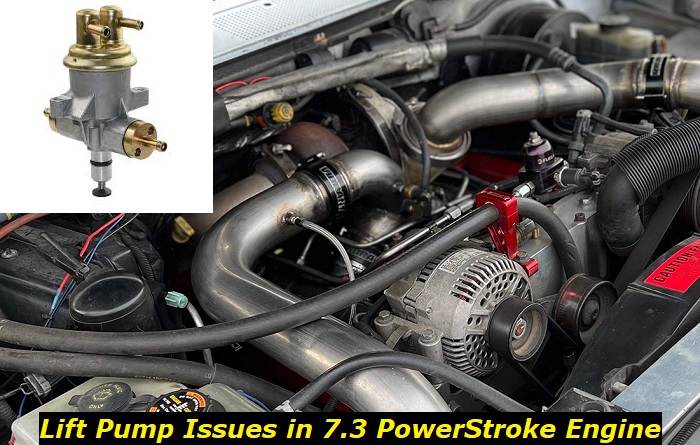The 7.3 Powerstroke is seen by many as one of the most reliable engines ever produced for vehicles. Although the engine dates back between 1994 and 2003, it is still utilized in a wide range of vehicle applications, especially in engine swaps.
Key features and my opinion about the engine
- Production years:1994-2003
- Average lifespan of 7.3 Power Stroke:380,000-450,000 miles
- Fuel supply type:direct injection
- Power range:250-275 hp
- Fuel efficiency:bad
- Engine block material:cast iron
- Engine reliability score:high
- The most common problems:electronics problems, wiring issues, pretty bad fuel economy.

Most Common Lift Pump Problems in the 7.3 PowerStroke
According to reports, mechanics, and complaints from owners, here are the most common problems that the 7.3 Powerstroke lift pump is prone of:
1. Inadequate Fuel Pressure
The stock mechanical lift pump equipped in the early years of the 7.3 Powerstroke, which was produced somewhere between 1994 and 1997, has specs that say it provides 40 to 70 psi fuel pressure to the injectors.
Based on many actual tests though, it is only somewhere between 40 to 45 psi. For stock injectors that's not enough. A lot of mechanics recommend having around 65 psi of fuel pressure to preserve the integrity of the injectors and to get optimum engine performance.
As a result, a lot of 7.3 Powerstroke owners have decided to take out the original lift pump of the engine and had it replaced with a chassis-mounted electric lift pump. That leaves a huge gap or hole in the block of the engine though, so they simply plugged it to prevent the contamination of the internal parts of the engine from dirt and other foreign debris.
Likewise, the installation of the electric lift pump in the chassis can be a bit laborious. Normally, this entails getting fuel lines with larger diameters and a bigger fuel filter. You'll also need to check the plastic line from the fuel tank to the factory lift pump for a secure connection.
It's important to make sure that everything is connected and routed properly in order for the electric fuel pump to work correctly. You'll also need to secure the electric lift pump with a bracket, and once that's in place, you're all set. Make sure to check all the connections with a socket wrench and proper torque as per manufacturer's specifications.
You must also make sure that the electrical harness is properly connected to the lift pump. Make sure that the lift pump and electrical harness are properly shielded from other car components to prevent interference, and it is equally advisable to check the engine's ground to ensure a secure connection.
Once everything is connected, you can start up the engine and monitor the fuel pressure. If it is within the 65 psi range, then you're good to go.
2. Overheating Lift Pump
Overheating in the lift pump of a 7.3 Powerstroke engine can have serious consequences on its overall performance. If not addressed promptly and correctly, it can cause major damage to the engine and affect its reliability, and in some instances, it can even be a cause of fire. To identify and address this issue, one must look for tell-tale signs and symptoms, manually inspect certain components, as well as use diagnostic tools if necessary.
The most common causes of overheating in the lift pump are insufficient lubrication due to oil contamination or running low on fuel; worn out parts such as seals, gaskets, and hoses; contaminated fuel filter; clogged drain holes at the bottom of the pump housing that leads to moisture buildup inside the housing, among other problems.
Signs that indicate overheating in the lift pump are loud noises from the pump, reduced power, gradual engine failure, and low oil pressure.
To assess this issue, one must first manually inspect the fuel filter for any signs of contamination. If it is dirty or clogged, then the fuel filter needs to be replaced. Additionally, the hoses connected to the lift pump should be inspected for any signs of wear and tear such as cracks or leaks.
If a problem is found, then replacement would be necessary. Furthermore, if there are drain holes at the bottom of the pump housing then they should be checked for blockages which can lead to moisture buildup inside the housing and cause overheating.
If none of these issues are present, then diagnostic tools should be used to detect the particular source of the problem. Tools such as multimeters and fuel pressure testers can help diagnose issues with the lift pump and the adjacent components within the engine that may be affecting it.
Once the cause has been identified, necessary parts may need to be replaced to fix the issue. This could include seals, gaskets, hoses, or filters that have worn out due to age or contamination.
It's important to know what causes overheating in a 7.3 Powerstroke engine's lift pump and how to assess it properly to prevent major damage or failure of the engine. By looking for signs and symptoms, manually checking certain components, as well as using diagnostic tools if necessary, one can identify and solve this issue before it gets any worse.
3. Contaminated Lift Pump
A contaminated lift pump can wreak havoc on the 7.3 Powerstroke engine if not identified and fixed on time. The most common causes of this problem are dirt, rust, corrosion, or other particles that get into the fuel system and cause clogs or blockages within various components.
To identify the source of the issue, it is important to look for visual cues such as dirt at the bottom of an empty fuel filter housing along with symptoms like hard starting, sluggish operation, misfiring, and more. Additionally, tools such as a diagnostic scan tool can be used to pinpoint any problems present to properly analyze the situation.
If a contaminated lift pump is indeed found to be the issue at hand, then some steps can be taken to rectify the problem. Cleaning and replacing the fuel filter and air filter is generally a good starting point, as well as checking for particles or other debris in the fuel lines.
If these steps are not enough then it may be necessary to replace certain components such as the injectors, fuel pressure regulator, and lift pump itself. It is important to note that if any of these parts have been exposed to contaminated fuel for extended periods, they might already require replacement instead of just being cleaned up.
Once all of these elements have been addressed it may also be beneficial to run some cleaner through the entire system to ensure everything is running smoothly before putting the vehicle back into operation.
When dealing with a contaminated lift pump on a 7.3 Powerstroke engine it is important to take the necessary steps to fully analyze and identify the source of the issue, as well as taking the appropriate measures to fix or replace any affected components. Taking these steps will help ensure that the system runs optimally for years to come.
4. Lift Pump Failure
A failed lift pump on a 7.3 Powerstroke engine can be a serious issue that should be addressed quickly. If left unresolved, it could cause the fuel pressure in the injection system to drop and lead to an array of problems such as poor engine performance, reduced power output, or even stalling.
The most common causes for failure are contamination due to water or dirt entering the fuel line, excessive wear on the rotor and vanes, as well as damaged O-rings and seals from old age. The earlier issues raised in the preceding item of this list can be the ones to blame for this problem, too.
To diagnose this problem effectively, one must first look for certain symptoms: knocking noises in the injector pump area; abnormal exhaust smells; low engine power with rough idle; or reduced acceleration. Visual inspections should also be done, such as checking for clogged filters or fuel leaks. A scan tool and a specialized testing device can help pinpoint the cause of the problem.
Once the diagnosis is done, there are several solutions available to address the issue. Cleaning with special chemicals like diesel purge or ethanol could do the trick if it's not too severe. If that fails, then replacing certain components may be necessary; this includes a lift pump, O-rings, seals and gaskets, and possibly even an injector pump rebuild kit depending on how badly damaged they may be.
It is important to remember that when dealing with any issues related to a 7.3 Powerstroke engine, proper diagnosis should always come first before any repairs are attempted. A failed lift pump, although a potentially serious issue, can be addressed in the right way if one takes the necessary steps to ensure a proper diagnosis and follow it up with an effective repair solution.
With that said, timely intervention is key to avoiding any further damage or harm to the engine's overall performance.
Conclusion
These are just some of the most common problems associated with the lift pump of the 7.3 Powerstroke. No matter what the cause is, it's important not to try fixing or replacing any components without first getting professional help. Doing so might cause more harm than good and may even result in costly repairs and replacements.
The article should also be used for general informational purposes only and not intended to encourage DIYers when dealing with problems related to the 7.3 Powerstroke engine lift pump. As seen here, many factors affect the operation of the lift pump and this can be made more complex if other parts are directly or indirectly triggering the issue.
About the authors
The CarAraC research team is composed of seasoned auto mechanics and automotive industry professionals, including individuals with advanced degrees and certifications in their field. Our team members boast prestigious credentials, reflecting their extensive knowledge and skills. These qualifications include: IMI: Institute of the Motor Industry, ASE-Certified Master Automobile Technicians; Coventry University, Graduate of MA in Automotive Journalism; Politecnico di Torino, Italy, MS Automotive Engineering; Ss. Cyril and Methodius University in Skopje, Mechanical University in Skopje; TOC Automotive College; DHA Suffa University, Department of Mechanical Engineering






Add comment